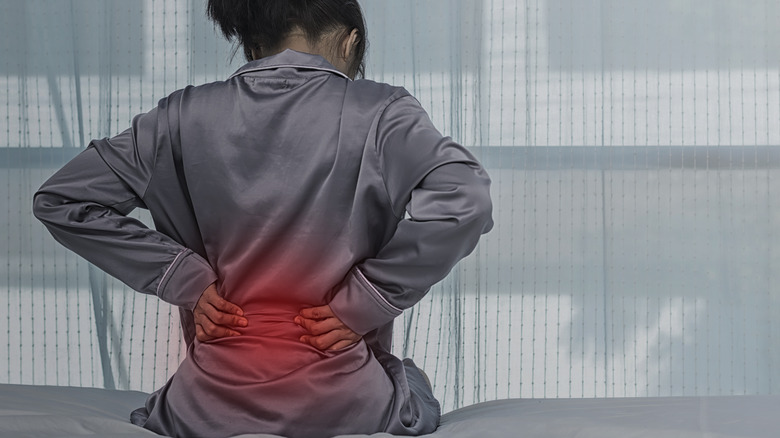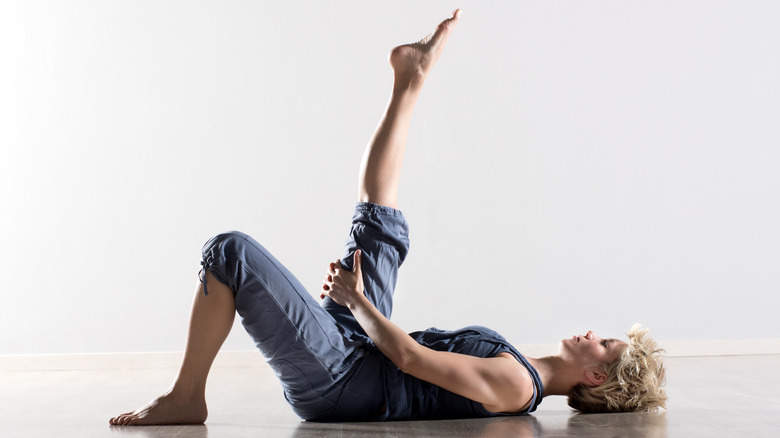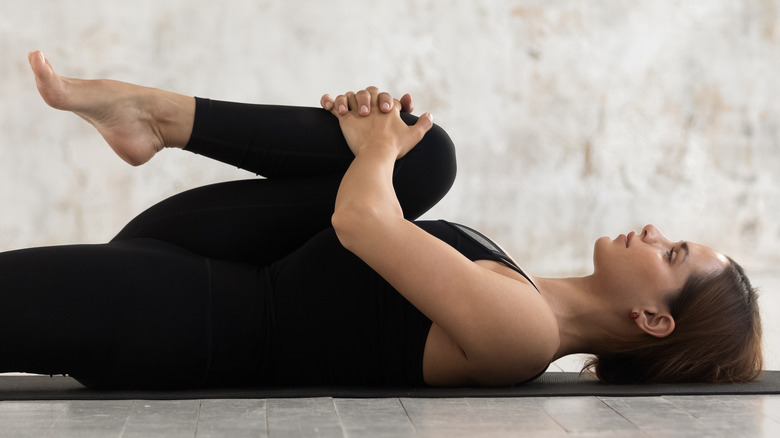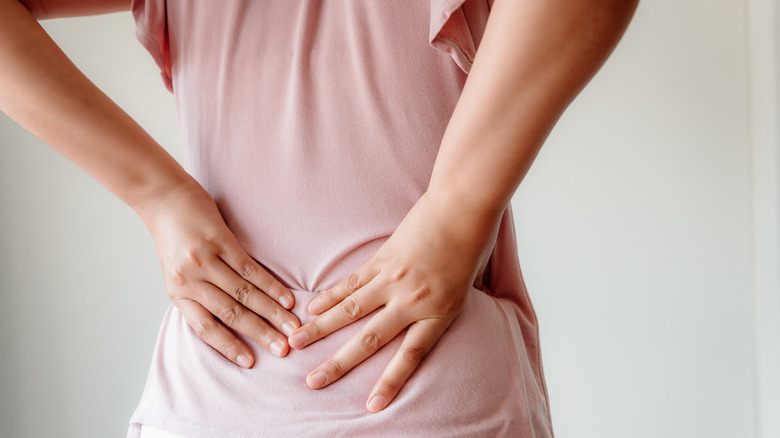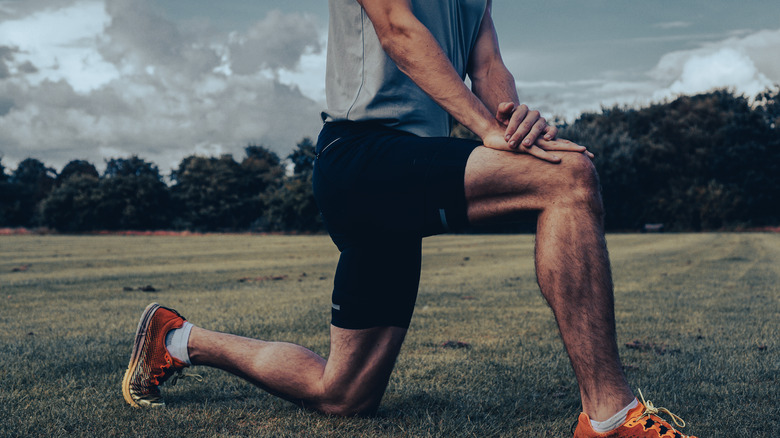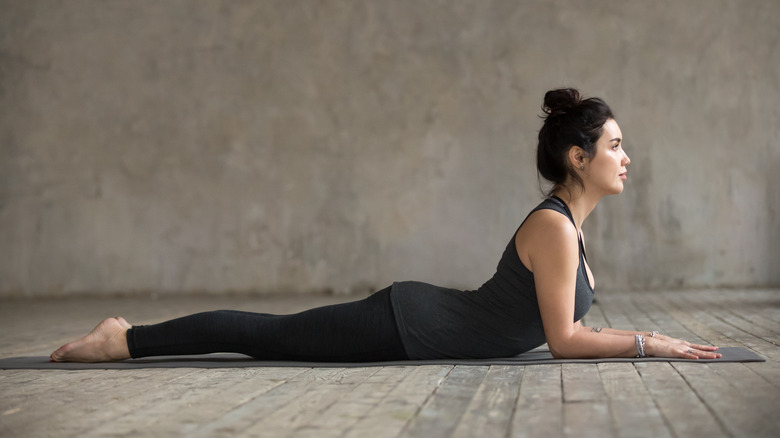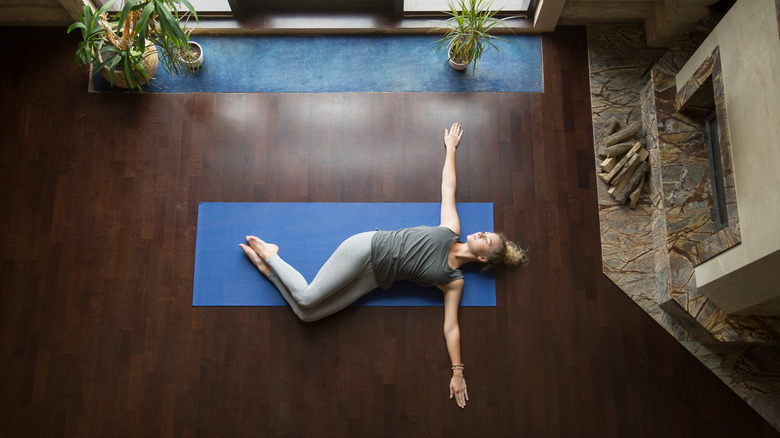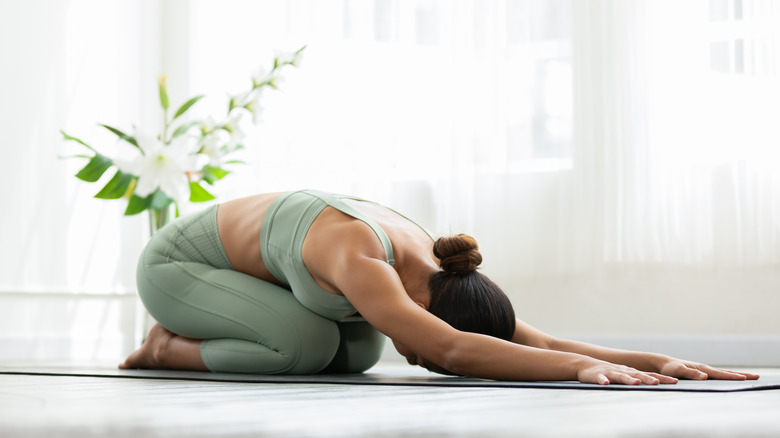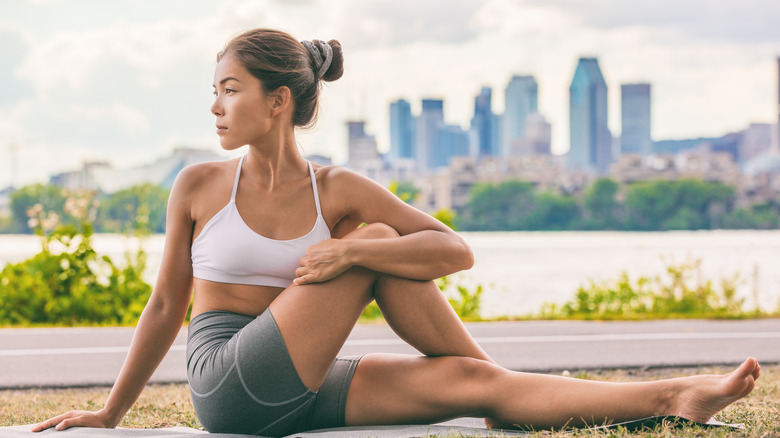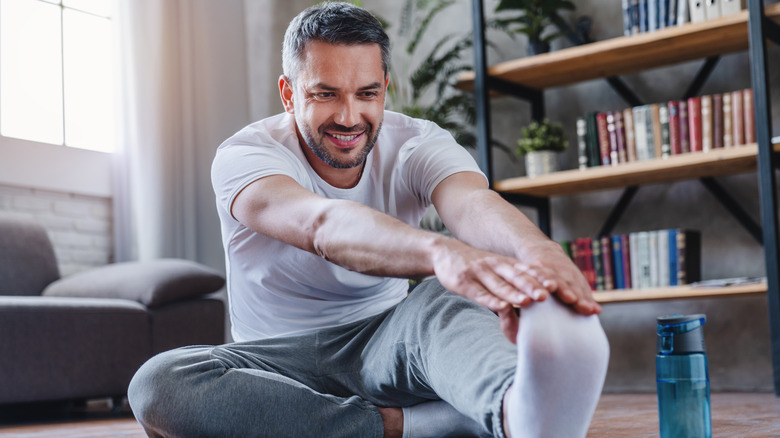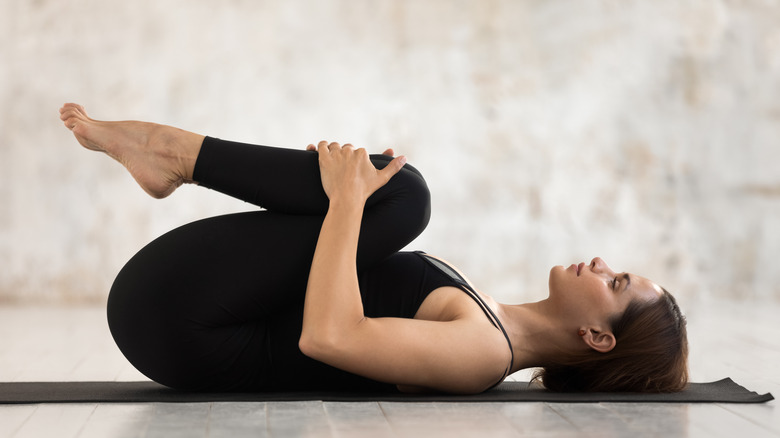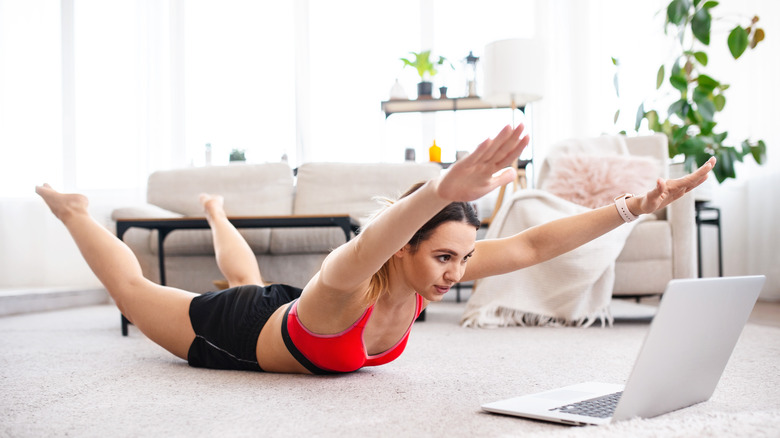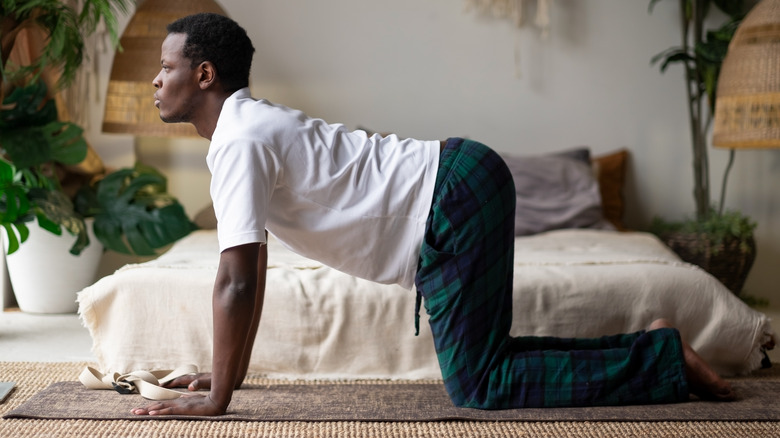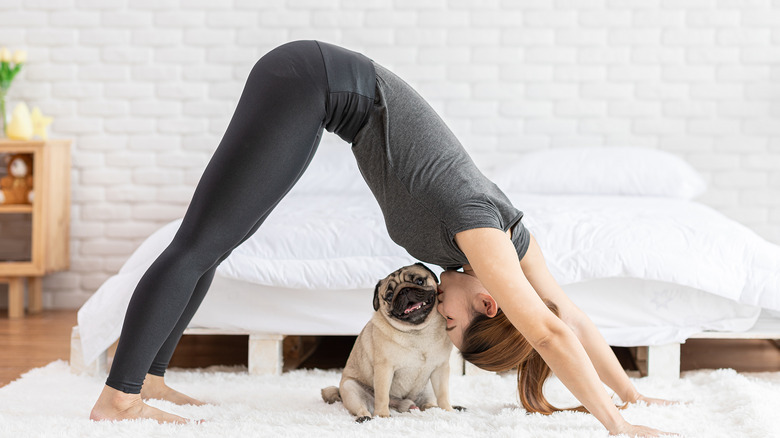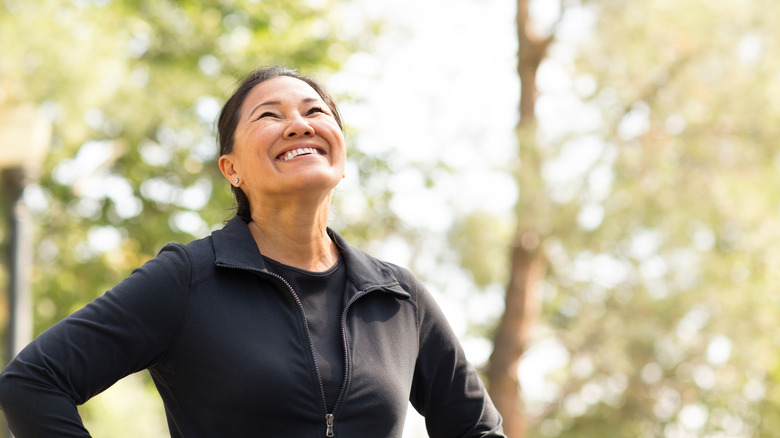The Best Stretches You Can Do For Your Lower Back
The best stretches you can do for your lower back are gentle and easy to control. You'll need to move and stretch in ways that alleviate — not aggravate — your pain. That's why many popular lower back stretches come from activities like yoga, which are focused on moving without excessive strain or tension. It's important to move when you have back pain, and stretching is possibly the best way to reduce pain enough to help you move (via WebMD).
Roughly 60 to 80% of adults in Western countries suffer from lower back pain, according to a 2016 review published in Healthcare. The researchers looked at 14 studies to figure out whether exercise, stretching, strength training, or stabilization exercises were best for reducing chronic lower back pain. They found that most of the interventions helped. Stretching, they noted, was important to loosen the muscles, tendons, and ligaments in the lower back. Doing so helped the participants in the study move without pain.
The review went on to recommend a general exercise routine with aerobic, strength training, and core-focused workouts in addition to stretching. Movement should help your lower back pain. However, if certain exercises make your back hurt more, it's best to avoid them and find an alternative. By working around your pain instead of through it, you avoid exacerbating any injury you may have.
Lying hamstring stretch
The long muscles that run down the back of your legs from your butt to your knees are the hamstrings. If you can't touch your toes, they're probably too tight. To loosen them, start with the lying hamstring stretch, as recommended by the University of California, Berkeley. This move is helpful for those with intense lower back pain because you get to lie down, relieving pressure on the spine and giving you more control over the stretch.
Lie on the floor with both legs flat on the ground. Lift your right leg, keeping your knee as straight as possible. Grab the back of the thigh with both hands, as close to the knee as possible. Gently pull on the leg, keeping the knee straight, to stretch the hamstrings. Point your toes towards your shins, and reach your heel up towards the sky. Hold this stretch for one minute, then switch legs.
Single knee to chest
If your back muscles are so tight that you have difficulty moving, the single knee to chest can help. Similar to the lying hamstring stretch, you can do this move on your back. It's a gentle move that stretches your hips and lower back muscles. When you're in a lot of pain, it's best to avoid aggressively stretching the back. This move only allows your lower back to move slightly, limiting your range of motion.
Start on your back with both feet flat on the ground and knees bent. Grab one knee with both hands and pull it in towards your chest. Gently tug on the knee until you feel a stretch in your lower back and the back of your hip. It's best to do this stretch for multiple repetitions, according to the University of California, Berkeley. Hold your knee for 15 seconds before switching legs. Repeat until you've done the stretch five to 10 times on each leg.
Standing back bend
Although it might seem counterintuitive, some back injuries warrant back bending stretches. If an injury occurs while your lower back is rounded, bending backward could relieve your symptoms. Since this stretch is performed standing, it's best to move slowly and gently. The standing position can put more pressure on the spine than a lying-down stretch.
American Family Physician recommends this stretch to help with acute lower back pain. It's geared toward someone who's having a bad flare-up in their lower back and in need of quick relief.
Start by standing with both hands pressed into the curve of your lower back. Gently lean back, arching your spine, and reaching your shoulders behind your hips. Move slowly and with control. Hold the stretch for a few minutes, as long as it's not painful. Perform the standing back bend in the morning and night every day until your pain dissipates.
Kneeling hip flexor stretch
The hip flexor muscles run down the front of the body, from the front of your spine down to your knees. When you do the half-kneeling hip flexor stretch, you should feel a gentle tugging in the front of your hips and thighs.
Tight hip flexors are common, particularly in those who sit most of the day. When seated, the hip flexors are naturally shortened. This can lead to lower back pain. However, the kneeling hip flexor stretch, which is recommended by Kaiser Permanente, can help ease this pain.
Start with one knee on the ground. Your other foot should be planted in front of your body. Begin with both knees bent at a 90-degree angle. Keeping your torso upright, lean forward gently. The hip flexor in your rear leg should begin to stretch. Lean forward to deepen the stretch, but stop if you feel uncomfortable. Hold the stretch for 15 to 20 seconds before switching to the other side. Repeat two to four times on each leg.
Cobra pose
The standing back bend helps relieve pain by bending your lower back. The Cobra pose, which is a popular yoga pose, is similar. This pose, also known as a press-up, may be more comfortable than the standing back bend because it's performed on the ground. It's also a stretch for the abdominals, which can help if they happen to be tight.
While many yogis do this stretch with their hands on the ground and arms straight, Kaiser Permanente recommends starting on your forearms. This makes the stretch less intense, helping you ease into it.
Lie on the ground on your stomach, with your forearms on the ground. Your elbows should be under your shoulders. Keep your forearms down and hips on the ground. Arch your back and lift your chest. Continue to arch your back to accentuate the stretch. If you don't feel like the stretch is enough, put your hands on the ground and straighten your elbows. That gives you more room for your lower back to curve.
Trunk rotation
Your spine can bend forward and backward, but it also rotates. To stretch every area of your lower back, try incorporating some form of gentle rotation into your routine, provided it's not painful.
Depending on the problem you're facing with your lower back, rotation can relieve pain or make you more uncomfortable. The lying trunk rotation lets you gently test out the feeling of rotation on your lower back.
The Hospital for Special Surgery includes this stretch in its top five favorite back and neck stretches to do each day. Lie on your back with your feet planted flat on the ground and knees bent. Keeping your legs together, slowly drop both knees to the left. Let your hips rotate as your legs drop to the side. Keep both shoulders flat on the ground. Hold the stretch for 3 to 5 seconds before switching sides. Repeat 10 to 15 times on each side.
Child's pose
Embraced for its relaxing nature, child's pose is among the most well-known of all yoga poses. Provided you don't feel any pain, it's an easy way to relax and stretch tight lower back muscles. Those with knee pain might want to modify the stretch by placing a blanket or foam roller above their calf muscle, to prevent deep flexion of the knees (Yoga International). Even though it's a benign stretch, ease into it slowly. As your lower back relaxes and rounds, your pain could be exacerbated.
Start kneeling with your butt on your heels and hands on your knees. Slowly walk your hands forward on the ground in front of you as you bend over. While some instructors encourage you to put your forehead on the ground, the South Carolina Spine Center recommends keeping your head off the ground. When you feel like you can't comfortably lean forward anymore, pause and begin counting. Hold the stretch for 30 seconds, then come out of it. Repeat three times.
Sitting rotation stretch
For a combination hip and lower back stretch, try the sitting rotation stretch. Specifically, you'll work the large glute muscle in the hip and lower back muscles that run down the sides of your spine. You'll also stretch the piriformis muscle, according to the American Academy of Orthopaedic Surgeons. Tightness and inflammation of this small hip muscle can cause a lot of discomfort in your butt and even lead to sciatica, which radiates pain down your leg.
To do the stretch, start seated with your legs flat on the ground. Cross your right leg over your left, and plant your right foot outside your left knee. Take your left arm and reach it in front of your right knee. Press into the knee with your arm and gently rotate to the right. As you do, plant your right hand behind your torso for support. Look over your right shoulder and hold the stretch for 30 seconds before switching sides. Repeat on each side four times.
Modified seat side straddle
Commonly known as the hurdler stretch, the modified seat side straddle targets your hamstrings and the muscles of your lower back. This stretch can be intense if your hamstrings are tight, so ease into it slowly. You can also put an elastic band around the bottom of your foot as you stretch to gently pull yourself forwards. More flexible individuals can grab their entire foot during this stretch. Since it lengthens your hamstrings and lower back muscles simultaneously, this stretch can be very helpful for lower back pain.
Sit on the ground with both legs in front and your knees as straight as possible. Bend your right knee and place the bottom of your right foot against the inside of your left knee. Keep your left knee straight. Reach towards your left foot with both hands but keep your back straight, advises the American Academy of Orthopaedic Surgeons. Hold this position for 5 seconds, then bend your back and bring your hands down to rest on your shin or ankle. Bring your head down towards your knee and hold this stretch for 30 seconds. Relax for another 30 seconds before switching to the other leg. Repeat 10 times.
Double knee grab
With the double knee grab, you can gently stretch your lower back. It has the added bonus of pressing the bottom of your back into the floor, which you can use to gently massage yourself. While in the stretch, rock side to side or spin your knees in a circle to move your lower back over the floor and gently press into your muscles. This mini-massage might help relax your lower back and alleviate some pain (via Prevention). Harvard Health Publishing recommends the double knee grab as a progression from the single knee grab.
Start on your back with both feet planted on the ground. Your knees should be bent. Grab your left knee with your left hand, then your right knee with your right hand. Gently pull your knees in towards your chest until you feel a gentle stretch in your hips and/or lower back. Hold this position for 5 to 10 seconds, then release your knees and set your feet back on the ground. Repeat this move five to 10 times.
Superman
Although it could be considered a strength exercise, the Superman stretches the front of your body and works the lower back muscles. It is a low-intensity exercise, Daniel Hass, a doctor of physical therapy, told the Cleveland Clinic. Hass explained that the pose shouldn't be performed on its own, but rather as part of a comprehensive back care plan. You can include it in your program to build strength and stability in your lower spine.
Lie on your stomach with your arms stretched in front of you. Simultaneously lift your arms, legs, and chest off the ground. Lift as high as you comfortably can, hold for a few seconds, then drop back down. Even when you relax at the bottom of the movement, try to "maintain tension in your muscles," advises Hass. Perform two sets of 12 to 20 repetitions before stopping, and perform each rep slowly with control.
Cat-Cow stretch
Many yoga poses help to ease back pain, but Johns Hopkins Medicine recommends the Cat-Cow pose, in particular, for pain relief. From the all-fours position with your hands and knees on the ground, you remove most of the stress that gravity places on the spine.
This unique combination of flexing and extending movements loosen the muscles around the spine and help you gently gain mobility while avoiding pain. Start gently with this movement — there's no need to move too far or too fast. Slowly increase your range of motion through each repetition.
While on all fours, your hands should be under your shoulders and knees under your hips. Begin by tucking your chin to your chest and rounding your back as far as you feel comfortable. Then, slowly lift your head as your arch your back and lift your chest. Repeat slowly but continuously for 1 minute.
Downward-Facing Dog
If the standing toe touch is uncomfortable for your lower back, the Downward-Facing Dog might be the answer. You can still stretch your hamstrings but there's less pressure on your lower back. According to Nebraska Spine Hospital, this exercise strengthens your core and stretches your lower back and hamstrings. However, they recommend that if your back pain is severe, you should avoid trying yoga.
To perform this pose, start at the top of a pushup position. Lift your hips up in the air and rock your weight back onto your feet. Keep your elbows straight and look down towards your feet. Keep your back flat and, if your hamstrings are too tight or your back starts to hurt, bend your knees slightly. Hold the stretch and continue to lift your hips higher until you can't anymore. Maintain that position for 30 seconds or until your shoulders are tired. Repeat three times.
Walking
Stretching can relieve back pain and decrease stiffness, which helps you move better. However, sometimes the pain is too great or you're simply too stiff to reap the benefits of stretching. Consider starting with walking, a low-intensity form of movement — one that will keep you out of your chair longer. Sitting is a contributor to lower back pain, physician-researcher Dr. Jonathan Lurie told MedLine Plus Magazine. He explained that moving around is better than lying or sitting for those suffering from lower back pain. "There is evidence to show that bed rest for acute back pain does not improve things and leads to greater disability," he revealed.
Getting up and going for a walk might be one of the best things you can do for your lower back pain. It can act as a warmup for your stretching or strengthening routine as well. Walking can be done every day and it counts towards your exercise goals. Of course, if nothing is working and your back pain continues to worsen, it's best to see a doctor.
Walking, stretching, and practicing yoga certainly help, but there are some problems that can only be remedied with medication or surgery. Your doctor will be able to guide you towards the proper treatment.

